According to the Endosymbiotic Theory, Which of the Following Inferences Can Be Made?
When we call back of development, we tend to think of a competition where the fittest survive. Male rams with behemothic curling horns defeat smaller males and earn the privilege of passing on their traits – big strong bodies and massive crimper horns – to the adjacent generation. Similarly, male birds with showy, colorful feathers win the contest for mates against deadening-looking males, and requite their offspring the gift of flashy plumage. But the story of evolution isn't always about competition. In fact, sometimes, evolution can be virtually cooperation. Such is the case with eukaryotic cells.
The origin of eukaryotic cells
Eukaryotic cells differ from prokaryotic cells in that most of the various organelles in eukaryotic cells are encapsulated in membranes, while prokaryotic cells have only costless-floating organelles (Figure 1). The difference is a very obvious one, even when viewed through the simplest microscopes. As early on as the belatedly 1800s, scientists were already debating how evolution may accept given rise to these two very distinct lineages (Mereschkowski, 1910).
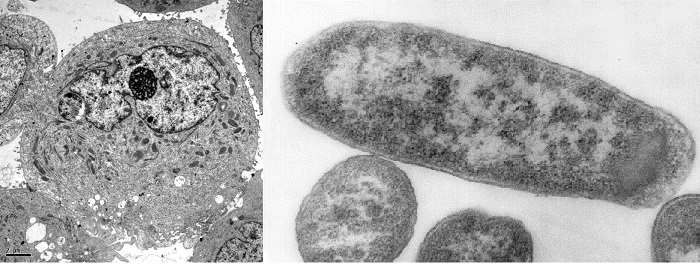
Konstantin Mereschkowski (Figure 2) originally proposed the idea that chloroplasts in plants evolved from a symbiotic relationship similar the one he had seen in his research with lichens. Lichens, he had observed, were actually blended organisms formed by a fungus and photosynthetic algae living together symbiosis. The fungus part of the organism provides a safety environment for the photosynthetic algae, and the algae photosynthesize ATP for the lichen. Mereschkowski suspected that the chloroplasts in constitute cells descended from organisms similar to the algae in his lichens. Unfortunately, he had no real evidence to back up his hypothesis, so no one took it very seriously at the time. However, when an American biologist named Lynn Margulis (Figure two) proposed the thought over again in 1967, things were different. Technology was becoming bachelor that would allow scientists to gather data and investigate the merits fully. Mereschkowski's idea finally got some attending, although 100 years afterward.
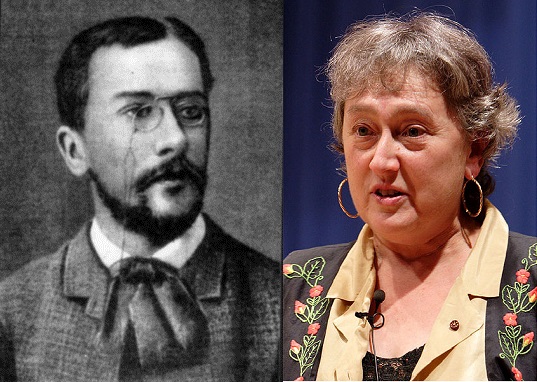
The theory of endosymbiosis
The idea proposed by Margulis is called the theory of endosymbiosis. This theory states that modern-day mitochondria and chloroplasts are really the descendants of ancient bacteria-like organisms that began living inside prokaryotic cells when Earth was very young (Sagan, 1967).
The story begins over ii billion years agone when Earth was however hot and more often than not barren. There was no oxygen gas (O2) in the temper, and the only life forms on Globe were single-celled prokaryotic organisms similar to present-day bacteria. Some of these prokaryotes, called cyanobacteria, evolved the power to capture the energy in sunlight to make organic molecules. Considering of their new abilities, these photosynthetic bacteria flourished and began to release costless oxygen gas (O2) into the sea h2o.
Oxygen gas was purely a byproduct of photosynthesis and hadn't previously existed on the planet. Because oxygen is reactive, it was toxic to most of the prokaryotes living at that fourth dimension and acquired many of them to get extinct. However, a small number of prokaryotes evolved the ability to tolerate the oxygen, and some of their descendants afterwards evolved the ability to utilize oxygen to aid their metabolism, much like nosotros do today.
Cells that can use oxygen for metabolism are called aerobic, while those that cannot are chosen anaerobic. Aerobic cells have a powerful reward because oxygen allows them to become much more than energy out of the food molecules they consume.
The cooperation between the ii prokaryotes came well-nigh when a large anaerobic cell engulfed (but failed to assimilate) a smaller, aerobic jail cell. The aerobic cell, now living inside the anaerobic jail cell, continued to efficiently metabolize food molecules using oxygen, and shared its excess ATP (chemical storage form of energy) with its host, the big anaerobe. The organization would have been similar to the one nosotros see in our own digestive arrangement: Millions of microbes live happily in our intestines, helping u.s.a. to digest and metabolize the foods we eat. Like the microbes living in our guts today, the aerobic cell lived entirely inside its host.
Over millions of generations, the cells continued to grow, divide, and multiply, and their relationship evolved into a mutually beneficial cooperation – a symbiosis. In fourth dimension, well-nigh (but not all) of the Deoxyribonucleic acid from the smaller aerobic jail cell fabricated its way into the nucleus of the host cell and the two separate organisms became 1 – the antecedent of all the eukaryotic cells we run into today. The descendants of that small aerobic prison cell evolved into the organelle we phone call mitochondria. Mitochondria yet laissez passer on some of their own Dna to their daughter cells, just as DNA from the nucleus is passed on to the nucleus of its daughter cells. The fossil record shows usa that mitochondria and modern eukaryotic cells look much different than the precursors did because they have connected to evolve and change over two billion years.
The endosymbiotic theory goes on to say that chloroplasts evolved in a similar fashion. It proposes that a pocket-sized cyanobacteria (the photosynthetic bacteria mentioned earlier as the get-go source of oxygen gas) was engulfed by a larger, aerobic, non-photosynthetic cell. This big non-photosynthetic cell, a descendent of the symbiosis described above, already had mitochondria living inside information technology. It was either an early eukaryote or an advanced prokaryote that shared some features with eukaryotes. And merely equally before, when the larger cell engulfed the smaller jail cell, it failed to digest it. The cyanobacteria, similar the aerobic cell before it, lived happily tucked inside the larger cell. The larger cell now had both an aerobic prison cell and a photosynthetic prison cell living inside it!
The system could have been very like to what we come across in mod 24-hour interval single cell organisms called Paramecium bursaria. P. bursaria ordinarily alive in ponds and eat large quantities of photosynthetic algae that they do not digest. The algae continue to photosynthesize within the about completely transparent host, providing the paramecium with an onboard renewable nutrient source. The paramecium host contributes to the symbiosis by transporting the algae to sunny spots in the pond while protecting information technology from more harmful, less accommodating predators. It too shares nutrient that information technology is able to discover with the algae during times when sunlight is scarce.
Just equally with the earlier symbiosis, the cooperative arrangement between the photosynthetic cell and the larger jail cell was mutually benign. The small photosynthesizer was provided with protection and all the nutrients that it needed, including lots of ATP since the large jail cell was aerobic. The large jail cell benefited fifty-fifty more. With the small cyanobacteria inside it, the cell no longer had to search around for food to consume – it had a built-in source of high-energy molecules fabricated by its new photosynthetic helper. Over millions of years, the cooperation became closer, and the descendants of the pocket-size cyanobacteria are now an entirely dependent organelle called the chloroplast. The large cell, at present both aerobic and photosynthetic, gave ascension to all plants and algae that nosotros come across today.
The theory of endosymbiosis sounds pretty far-fetched, and the scientific community didn't buy information technology at first. But Lynn Margulis was persistent and worked tirelessly to gather difficult bear witness to support her theory. She finally got the proof she needed in the late 1970s when scientists adult a new tool for identifying the bequeathed lineage of organisms.
Comprehension Checkpoint
Evolutionary changes
Confirming the theory
Margulis originally conceived of the idea of endosymbiosis based on what she observed in the laboratory as she studied Euglena, a unmarried-celled, photosynthetic eukaryotic organism. The chloroplasts inside the Euglena reminded Margulis of bacteria she had studied before. The chloroplasts had Deoxyribonucleic acid that was round like the DNA in bacteria (Effigy 3).
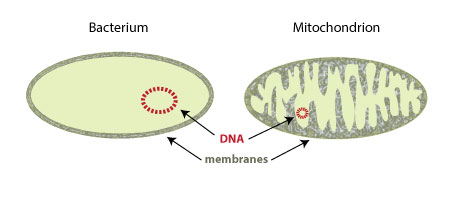
The mitochondria in Euglena also had similarities to gratis-living bacteria. For example, they pinched themselves in half as a means of reproduction in a process that looks a lot like binary fission (Figure 4) (see our Prison cell Partitioning I: The Prison cell Bicycle module for more data).

Just considering mitochondria look like bacteria wasn't plenty to convince most scientists that the organelles really descended from bacterial ancestors. Gathering conclusive testify that present-mean solar day mitochondria and chloroplasts are distantly related to leaner was a very difficult thing to do in the 1960s. However, in the 1970s, scientists developed a method for reading the precise sequence of nucleotides present in an organism's DNA. The new technique immune scientists to compare the genome of one species to that of some other and look for similarities that betoken relatedness. More similarities between the genomes of ii species suggest that they are more than related. Fewer similarities suggest that ii organisms are less related.
Using the new DNA sequencing techniques, Ford Doolittle and Michael Gray, scientists working at Dalhousie Academy in Halifax, Nova Scotia, constitute the evidence needed to convince the scientific customs that Margulis was right. They compared the Deoxyribonucleic acid from chloroplasts to DNA from the nucleus of the same cell. And so they compared the chloroplast DNA to an aboriginal line of free-living photosynthetic bacteria.
They constitute that the chloroplast DNA appeared to exist more closely related to the bacteria than to the nuclear DNA of plants or algae. Not long afterwards that, they showed that mitochondrial DNA, or mtDNA, was more closely related to an ancient line of free-living aerobic bacteria than to nuclear Deoxyribonucleic acid of the eukaryotes that host the mitochondria. The reaction in the scientific community was swift. Margulis's explanation for the origin of mitochondria and chloroplasts in eukaryotic cells quickly became the ascendant view. More bear witness continued to pour in and by the early on 1990s in that location was solid scientific consensus that the hypothesis of the endosymbiotic origin of mitochondria and chloroplasts was indeed right (see list below). It was the first documented case of cooperation, rather than competition, driving a major evolutionary innovation.
Major evidence for the endosymbiotic theory
- Mitochondria and chloroplasts accept some of their own Dna, and it is located on a circular chromosome (similar to bacteria).
- Mitochondria and chloroplasts have their own ribosomes, and they are similar to bacterial ribosomes, non to the eukaryotic ribosomes found in the cytoplasm.
- Proteins that are fabricated inside mitochondria and chloroplasts begin with N-formyl-methionine, like bacterial proteins, non similar eukaryotic proteins, which e'er begin with regular methionine.
- Mitochondria and chloroplasts split and replicate on their own in a mode very similar to how bacteria divide, called binary fission.
- At that place are transport proteins found in the membranes of mitochondria and chloroplast, called porins, that are constitute in bacterial, but not in eukaryotic, plasma membranes.
- Mitochondrial DNA sequences are more similar to bacteria genes than to any eukaryotic genes.
- The modern-day bacteria whose Deoxyribonucleic acid is most similar to mitochondrial DNA is the Rickettsia genus. These bacteria alive within large eukaryotic cells as parasites.
- Chloroplast DNA sequences are more similar to cyanobacteria genes than to whatever eukaryotic genes. Cyanobacteria are modern-twenty-four hours photosynthetic bacteria.
The appearance of Dna sequencing and the power to compare Dna betwixt dissimilar species has also shed light on the probable identity of the large prison cell that first engulfed the ancestor of the mitochondria. While the mitochondria and the chloroplasts appear to be descended from bacteria, the Dna in the nucleus of eukaryotic cells is more than similar to modernistic-day archaea than to that of bacteria. Nosotros tend to think of archaea equally arcane organisms relegated to life in farthermost environments, far outnumbered past their fellow prokaryotes, the bacteria. Nonetheless, they were once the dominant life forms on the planet, and scientists today are finding them in more and more than surprising places. Due to the similarity of our nuclear Deoxyribonucleic acid to theirs, it is likely that the large cell that engulfed the antecedent of the mitochondria was an archaea, which ways that all eukaryotes – including u.s.a. – are descendents of archaeans through our nucleus, and of bacteria through our mitochondria. It'southward about every bit if the two prokaryotic domains of life, leaner and archaea, joined together and gave rise to the eukaryotic co-operative of the tree of life.
Comprehension Checkpoint
The near convincing testify that organelles such equally mitochondria and chloroplasts descended from bacteria was
The development of other organelles
But what about the nucleus constitute in eukaryotic cells? How did that evolve? The membrane-bound nucleus, maybe the single-about defining characteristic of eukaryotic cells, in no fashion resembles any gratuitous-living bacteria or achaean. The nucleus and other organelles evolved in a very different fashion than did the mitochondria and chloroplasts (Figure 5).
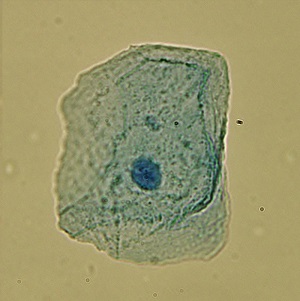
Biologists cannot say for certain the exact order in which all of the organelles evolved. The fossil tape is difficult to read when it comes to tiny, fluid-filled microorganisms from billions of years agone. Further complicating the matter is the fact that some organelles appear to have evolved more than once in dissimilar lineages over evolutionary time. In short, there is still some debate almost the details of the chronology, but scientists can infer the basic sequence of events based on what we know about how the organelles office today.
Early prokaryotic cells, the first forms of life on Earth, probably had a rigid jail cell wall, like prokaryotes practice today. Inside the jail cell wall there was a plasma membrane, like all cells have (see our Membranes I: Introduction to Biological Membranes module). Somehow, perhaps as the result of a mutation, the plasma membrane began to fold in on itself, creating a small cavern or – invagination – inside the cell wall (Figure 6). Over many thousands of generations, this invagination grew and eventually surrounded the prison cell's Deoxyribonucleic acid, creating a nuclear envelope. This architectural enhancement gave these cells an advantage over other prokaryotic cells because their Dna was at present improve protected from dissentious molecules found in the cytoplasm of the cells.
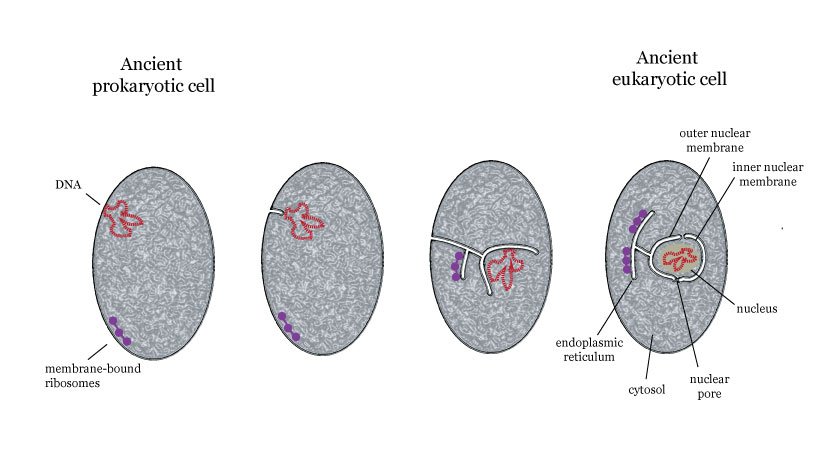
The nucleus offered some other important benefit. Inside the protective environment created by the nucleus, the Deoxyribonucleic acid was able to evolve in means that information technology never had before. Free from the interference from the cell'southward cytoplasm, new chemical reactions that power gene recombination, Dna repair, and gene expression somewhen evolved, and the construction of DNA itself began to modify. Dna evolved from its aboriginal course – the simple ring-like structure seen in leaner – to the long intricate strings of nucleotides that make upward our own Dna. With a unmarried evolutionary change – the development of a nucleus – eukaryotic cells were assail a course for greater multifariousness and specialization than prokaryotic cells could ever achieve.
Later on in their evolution, when eukaryotic cells acquired mitochondria and chloroplasts, they gained another advantage. Eukaryotic cells could at present find and utilize food sources better than their prokaryotic cousins. Eukaryotic cells began to grow larger. (The boilerplate eukaryotic cell today is 100 to 1,000 times larger than a prokaryote.) And as the cells became larger, their outer membrane continued folding in on itself in the same fashion that it had when the nucleus was formed. More folds created more than channels inside the cell, and the aforementioned process of invagination that formed the nucleus began to style the remaining membrane-jump organelles.
The compartments (or organelles) created spaces where new processes could evolve without interference from the rest of the cell. Membrane-bound organelles gave eukaryotic cells the aforementioned benefit that a proper laboratory gives a chemist – an environment where reactions can be controlled. Within the newly formed organelles, complex processes like protein synthesis were able to evolve without chemical disruption from other cell functions like respiration or photosynthesis. Eventually, pathways and other features developed in cells that enabled them to communicate with each other. And in one case cells were able to pass signals and cooperate, they began to develop larger symbiotic relationships that ultimately gave ascension to the tissues and organs that make upwards our bodies (Effigy seven).
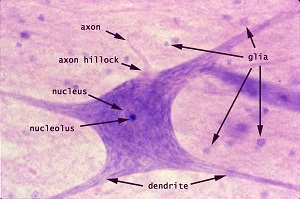
While the explanation above is an educated guess, it is bolstered by evidence from modern-day prokaryotes, the bacteria. Many bacteria have invaginations in their membranes that they employ for a multifariousness of purposes. In fact, well-nigh bacteria have all-encompassing in-foldings of their plasma membranes that process nutrient molecules the same mode that mitochondria metabolize nutrient in eukaryotic cells. What this shows is that the evolution of membrane folds into internal compartments is not a far-fetched possibility. In fact, information technology still happens today and can provide clear advantages for cells.
The membranes surrounding the organelles of eukaryotic cells exercise more than than only provide a barrier between organelles and cytoplasm, however. They serve as a network that provides a means of communication and transport throughout the cell. The endomembrane system, also thought to have evolved via the process of invagination, illustrates this point nicely.
Comprehension Checkpoint
Complex processes like nerve impulses are more likely to be establish in __________ cells.
The endomembrane system
Camillo Golgi, an Italian physician working in the tardily 1800s, is said to have discovered the Golgi appliance when he was looking at cells from the torso'south fundamental nervous organization. The internal reticular appliance, equally he called it, appeared to exist an individual structure when viewed through his microscope, which was the cutting edge engineering science of the day (Figure 8). Today, nosotros know that the Golgi appliance is connected to a larger endomembrane system.
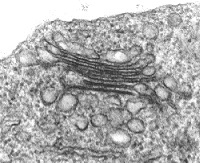
The endomembrane system divides the cell's cytoplasm into separate compartments, or organelles, that each performs specialized tasks within the cell. The separate compartments, even so, aren't entirely carve up. Some are really connected by shared membranes, every bit is the case with the rough endoplasmic reticulum and the nuclear membrane. This item network forms a pathway for large molecules and signals to pass between the nucleus and the surround outside the cell.
Compartments that don't share a direct concrete connectedness pass signals, proteins, and waste material via tiny membrane-spring sacs called vesicles. Vesicles grade when role of an organelle'south membrane pinches off, forms a lipid-bound sac, and floats through the cytoplasm to deliver its cargo between organelles. The vesicles, being formed of the aforementioned plasma membrane that surrounds the cell and all the organelles, easily merges with the membranes surrounding each compartment. Vesicles containing bones proteins synthesized in the rough endoplasmic reticulum travel to the Golgi apparatus for final processing via vesicles. Vesicles containing the finished protein leave the Golgi appliance and deliver the last production out to another organelle (Figure nine).
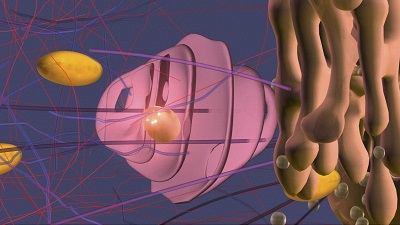
Our current understanding of the membranes surrounding organelles has come up from new techniques in biochemistry that requite researchers greater access to the inner workings of cells than the scientists of Margulis's day had. Researchers today tin sift through cell samples using centrifuges and isolate individual organelles for closer scrutiny. They can too track the motility of specific chemicals and proteins through a cell's system and witness get-go-hand the period of chemicals and signals from one organelle to some other. The result has been a greater understanding of the true spirit of cooperation that was the ground of the development of the eukaryotic cell in the offset place. As Lynn Margulis and her son wrote in one of their many books, "Life did non take over the globe by combat, merely past networking."
Summary
Evolution isn't always most competition. Information technology tin can as well be most cooperation, equally is the example with the development of chloroplasts and mitochondria from complimentary-living leaner. This module explains the theory of endosymbiosis along with its origins. Convincing show in support of the theory is presented. The evolution of the nucleus and other organelles through invagination of the cell membrane is as well discussed.
Primal Concepts
-
One of the principal differences between eukaryotic cells and prokaryotic cells is the presence of a nucleus and other membrane-bound organelles.
-
Chloroplasts and mitochondria have specialized roles in producing energy for the cell and have several unique features including some of their ain Deoxyribonucleic acid. Considering of this, scientists believe that both of these organelles originated through endosymbiosis when one small cell began to live inside a larger 1.
-
Membrane-bound organelles evolved as folds of the plasma membrane; this allowed these cells to establish compartments with unlike environments appropriate for the specific role that the organelle performs.
mitchellpultooper1981.blogspot.com
Source: https://www.visionlearning.com/en/library/Biology/2/Cellular-Organelles-I/195
0 Response to "According to the Endosymbiotic Theory, Which of the Following Inferences Can Be Made?"
Postar um comentário